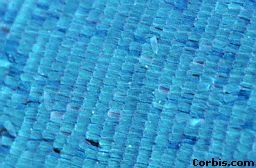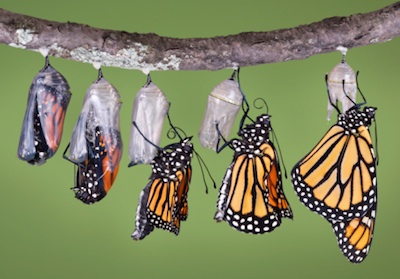Butterflies and moths are insects.
They have wings.
They have six legs.
They have a long, curled tongue.
They lay eggs and caterpillars hatch out of the eggs.
Butterflies and moths are very similar. Some people find them hard to tell apart. Some things about butterflies and moths are the same and some are different.
Butterflies and moths: Things that are the same
Seen under a microscope, the scales of a butterfly’s wing are clear. Image©Corbis
Butterflies and moths are insects, in the group of insects called lepidoptera (say lep-i-dop-turr-uh).
Their bodies have three sections: a head, thorax and abdomen. There are six legs joined to the middle section (the thorax), three on each side. They have two wings on each side of the body.
They have a long tongue called a proboscis (say prob-oss-kus), which is curled inside the mouth. The tongue uncurls for feeding, and is used like a drinking straw.
Their wings are covered with tiny scales. If you touch a butterfly or moth, you will see what looks like dust on your hand. The dust is actually tiny scales.
Some wings are colourful. Some wings have marks to scare away animals that might eat the butterfly or moth.
Wing patterns often look like the insect's habitat to provide camouflage. The insect looks like part of where it is resting and is harder for a predator to find.
Butterflies and moths: Things that are different
A butterfly proboscis (tongue) . At rest the wings are upright. © Getty Images
Butterflies have knobs at the end of their antennae, and moths never do. Many moths have feathery antennae.
Butterflies fly in the daytime, and when they rest, their wings stand upright.
Moths fly at night, and when they rest, their wings lie flat.
Moths have tiny hooks that join the top, or fore, wing to the lower, or hind, wing. Butterflies do not.
Moths have hairier bodies than that of butterflies.
Life Cycle of butterflies and moths
The life cycle of butterflies and moths is generally the same. Like many insects, they go through 4 stages: egg, larva (the word for more than one is larvae), pupa (more than one is pupae), and adult.
A butterfly laying eggs. © Getty Images
The butterfly or moth lays eggs on the food plant for the larvae.
Caterpillars eat and eat and grow © Getty Images
Larvae (caterpillars) hatch from the eggs. The eat the leaves of the plant.
They eat constantly, and every now and then as the caterpillar grows, its skin splits revealing a new and bigger skin underneath. This is called moulting. It is necessary because their skin doesn't grow.
A caterpillar getting ready to pupate. ©Getty Images
When it has grown enough, a caterpillar stops eating and attaches its tail firmly to a stick, and begins to form a chrysalis (butterfly) or cocoon (moth) around its body.
A butterfly chrysalis ©Getty Images
This is the pupa stage, and inside the chrysalis or cocoon, the caterpillar is changing, becoming a different creature.
This is called metamorphosis (met-uh-mor-fuh-sis).
After a few weeks, the adult emerges from the chrysalis or cocoon, and stretches out it wings so blood can flow through and open them up.
The adult lives for just a few days as it finds a mate, after which the females lay eggs.
Time lapse photo showing a butterfly emerging from its chrysalis. ©Getty Images
Information about butterfly life cycle and body and why they are important to have in your garden:
https://diygarden.co.uk/wildlife/ultimate-guide-to-butterflies/
How to attract butterflies to an Australian garden:
https://www.bhg.com.au/how-to-attract-butterflies
Read more about butterflies and moths:
http://www.kidsbutterfly.org/faq









